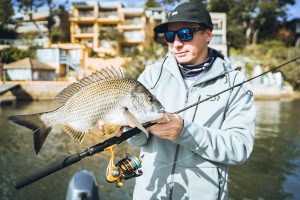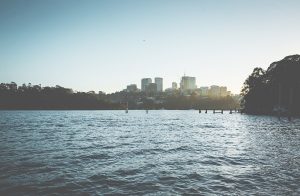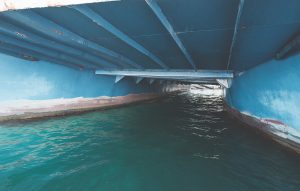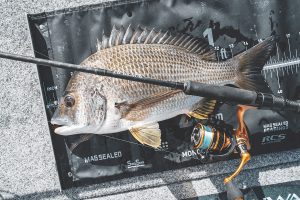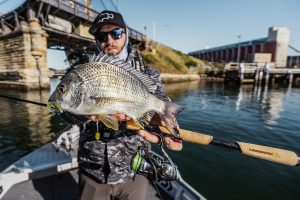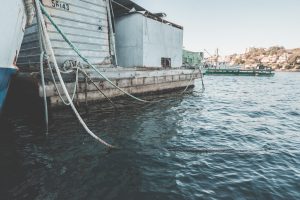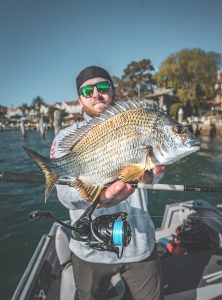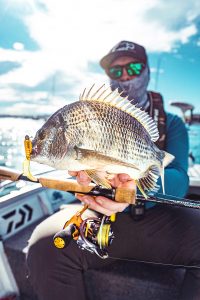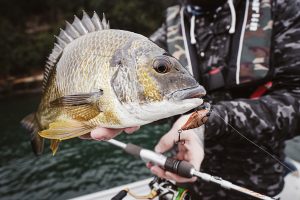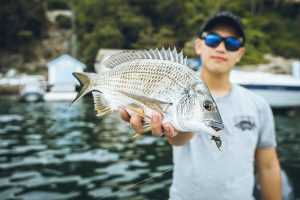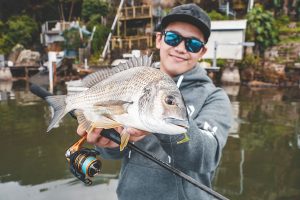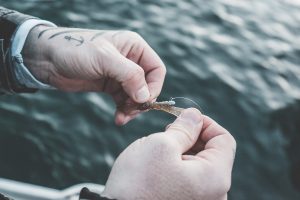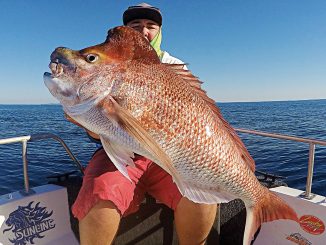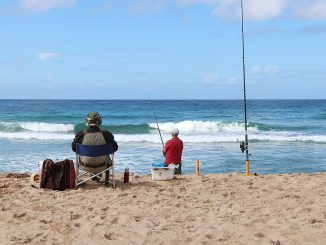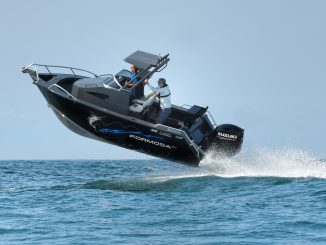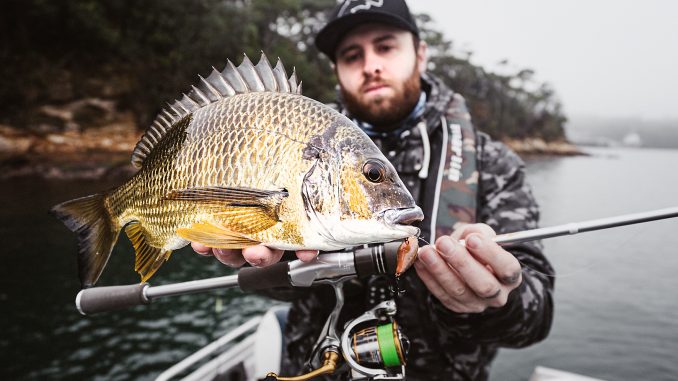
by Anthony Strati •
With so many of us living in built-up areas these days, we’re presented with new challenges when trying to fish. Not only are there environmental pressures like re-claimed land and water pollution issues, you also have to deal with huge numbers of people looking for those same good-sized specimens that you’re after.
Getting Started
If you live in an urban or inner city area and expect to hit the water and nail a big one two seconds in, you had better do the work before you get out there.
Research and repetition is key. With the abundance of YouTube videos, magazine articles, forum threads and the ever-reliable advice from old mate on the boat ramp, there is no better time to soak up all the different types of information regarding different fishing techniques and tackle for bream, which are many anglers’ first fishing experience.
Only a few years ago I was a novice to bream fishing in built-up areas, but nowadays I really enjoy it, and I like to share what I have picked up along the way and what has worked for me. Most of the time it’s good to keep your bream fishing techniques fairly simple, but you also need to be prepared for those tough days when you might have to lean on something you’ve seen a mate do, or picked up from tournament pros. Everyone has their own style and theories of what works, and this is one of the things which makes fishing so enjoyable. Trying out new techniques and seeing success is always rewarding.
Where to look
I live right on the Parramatta River, and when I want to escape the busy rat race of Sydney city, it’s easy to take the boat and go for a bream flick around the Parramatta River and Sydney Harbour. Growing up I was a predominantly a freshwater native fishing enthusiast, and it was enjoyable more me to take on the new challenge of urban bream, which are sometimes finicky and resilient fish. These bream have often seen every type of lure before, and will take some convincing before they make a strike.
When you’re urban fishing for bream (or other estuarine species), there is always something new to learn, or perhaps even a new way to approach a spot that might not have lived up to your expectations on the first attempt. Just because a spot is productive for another angler, doesn’t been you’ll easily catch fish there. It’s the little things anglers do differently that could turn an apparently fishless spot into your newest ‘spot x’.
Sometimes I have learnt more from fishless sessions than I have on days when I’ve had a livewell full of sizable fish. Although both these situations have made me a better angler, it’s turning a shutdown bite into a success that is a truly rewarding experience.
Sydney Harbour and the Parramatta River are absolutely stacked with bream and are very enjoyable to fish. This system is completely structure dominated, with both artificial and natural structure ranging from pontoons to moored boats, mangroves, bridge pylons, rock walls and wharfs. This is great because you can always switch it up and try something new, and it also gives you lots of options if there’s a crowd or the weather turns foul and you have to look for cover.
Techniques
Anyone who has been on my boat knows that I can’t go past throwing lightly-weighted plastics. ZMan or Prolure Grubs are my go to, either in the bloodworm or the famous motor oil colours on a 1/20oz – 1/12oz jighead with a no. 1 light gauge hook.
Throwing plastics into vertical structure is a favourite approach for bream anglers everywhere, and there’s lots of structure like that in urban areas these days. Nothing gets the heart racing for light line fisher than being connected to a brute deep in structure with your rod bent to the cork, and thinking, “am I going to land this?”
If we’re being honest, you’ll probably lose more of those battles than you’ll win. Still, there’s no glory in owning lures, and you have to be willing to donate a few if you want to play with the big boys!
The action and delivery of the lure can change from cast to cast, and on any day you should try a multitude of approaches until something works and you can figure out a pattern. This is particularly important in winter, when the fish aren’t as keen to bite. In winter I slow my lure action right down and work on adapting my approach to the situation, and I have found this to work very well. As the weather warms up I will adjust my fishing style accordingly.
Regardless of the time of year though, it’s important to adjust to variables such as the weather, tide and current. You can also do research on which spots turn on in different conditions. Being versatile like this is key to being a successful angler; it’s the difference between getting a live well full of fish or the dreaded donut.
How long should I wait?
If you’ve seen underwater footage of bream you’ll often notice that the bigger, smarter fish hang around at the bottom of the schools. For that reason, you want to keep your plastic hard on the bottom if you want to dodge the undersize models and catch the better quality fish.
It’s not unusual for me to let my plastic or crab imitation sit on the bottom for 10-20 seconds before I even start to work it off the bottom. Most of the hook-ups come during the long pause on the bottom where the tail on the grub is doing its thing, or just as I’ve given it a twitch off the bottom.
One of the biggest bream I’ve ever caught in Sydney Harbour was when I cast, let my plastic sink and realised I had to tie my shoe while the plastic was on its way to the bottom. By the time I had pulled tight on the bow, the rod was buckled and I was on! No fancy technique, just letting the lure sink and sit naturally. It was enough to bring big blue-nose bream undone. Maybe I should pay less attention more often!
Times and tides
Some of my favourite spots work better on the run-in and some work better on the run-out tide – it’s all about learning the ground you’re fishing.
The next time you go fishing the flats for bream, fish on a very calm day with no wind and then try the same spot with some wind. Wind on the flats can really turn the bite on, and long casts across the wind on the flats can produce solid fish. I usually run a shallow crank for flats fishing, or a dark coloured plastic if there is a lot of weed.
Fishing an area with zero wind is particularly difficult if you’re trying to tempt bream on surface lures. Even the slightest breeze can create enough ripple to disguise your lure and convince the fish that it’s a fleeing prawn with a ‘Hi, my name is Dinner’ sticker on it.
On those times where a small amount of rain has fallen the night before a planned trip, I have had more success. My theory is that the water pushing through drains that lead into the river and harbour systems brings a change to the bream’s diet. Swapping from my normal grub-style lure to a creature bait can be the difference between a donut and a photo that makes me Instafamous for a day!
Types of structure to look for
Approaching any of the many bridges in the river is a solid winner. The current pushes the bait against and past the pylons where bream are sitting just out of the current, waiting for an easy meal. The best approach is to punch a cast past the pylon and work the plastic with the current and as close to the structure as you possibly can.
Personally, whether out of a boat or a kayak, I find using a rod just over 7ft is my go-to for this application because it’s easier to guide the lure right along the pylon from my position, and this keeps the lure in the strike zone for longer. The extra length in the rod also makes it less likely that you’ll pull those small hooks from the fish’s mouths.
You can also fish pylons with a crankbait, using the same approach of fishing right up close and along the structure. Crankbaits are an absolute staple in my tackle selection for chasing bream around the city. If you’re new to targeting bream on crankbaits, a long cast with a simple slow roll retrieve is all you need to get started.
Lures and when to use them
The lures I enjoy using the most, and which absolutely dominate bream fishing, are the 2.5” ZMan Grub, the world famous Cranka Crab (heavy model) and Pro Lure crankbaits. My favourite kinds of structure to target with them are rocky edges and moored boats.
If the tide is low I generally flick around moored boats. I look for the boats closest to current zones, and most of the time this is the boats on the outside of the bunch. I throw crankbaits long past the moored block and position the tip of my rod so I can get the lure right up alongside the boat hull.
Throwing crankbaits around rocky edges or vertical structure within the Parramatta River and Harbour can also produce solid fish. I approach these spots when the tide is rising because I find the bream will be looking for food such as crabs and small baitfish. The system is boat traffic heavy but this can sometimes work in your favour, because the boat wakes can lift up debris or crabs from the rocks or vertical structure. Some of the resident bream will swim over to investigate, and others that are hiding around the structure will be ready and waiting to pounce on an easy meal. I’ve had good success in these situations.
When it comes to throwing Cranka Crabs or crankbaits for bream, a lot of people are dispensing with braid and leader in favour of straight-through fluorocarbon. I have started experimenting with it myself, and I’m finding that the extra stretch and low visibility of fluorocarbon is highly useful. As you’d expect, braid is still the better option for soft plastics, to give them the action they need.
Regardless of which setup you’re using, it’s important to use good quality line/leader. There have been times when my leader has gotten wrapped around a pylon and still been going strong afterwards. If you spend the extra bucks before you go out you’ll come home with a smile on your face.
Gearing up
I use Daiwa J-Braid Grand in 6lb for my braid set-ups, with 4lb Daiwa J Thread FC leader. I usually use one rod length of leader as a minimum. If the bite has really slowed down on that day I run 2-3 rod lengths of leader to really try to get those bites happening.
Reels in the 2000-2500 size are perfect for bream fishing, and I use a TD Sol III 2000 LT. It’s paired with a 7’2”, 2-5kg rod which gives me plenty of casting distance, has plenty of low-end power and is also light enough in the tip that I’m not pulling hooks and losing fish.
When it comes to rods, reels and line, at the end of the day it comes down to personal preference. Experiment and see what works for you.
SCENT
Sometimes you need to pull out all the stops to have an enjoyable day on the water in the competitive urban jungle. If you find yourself struggling when the bite is slower than it normally would be, or even completely shut down, try rubbing some scent on your lure. It might just be the final trigger they need to latch on.
During bream spawning season when their pheromones are through the roof, I have found that scents can be a real difference maker. If you’re fishing low and slow the fish will have time to come right up and sniff the lure and maybe even pick it up without properly swallowing it. A liberal amount of scent can be the silent salesman you need when the going gets tough.
That’s a wrap
Bream fishing is like any craft – the more time you spend doing it, the better you will become. Keep a log of tides, wind, weather and so forth on your fishing trips, to refer to in future. A fishing log gives you the knowledge to make the most of the system you’re fishing.
If you see me on the water come and say g’day! I’ll always be happy to share even more info with you, and hopefully get you onto some urban monsters.

